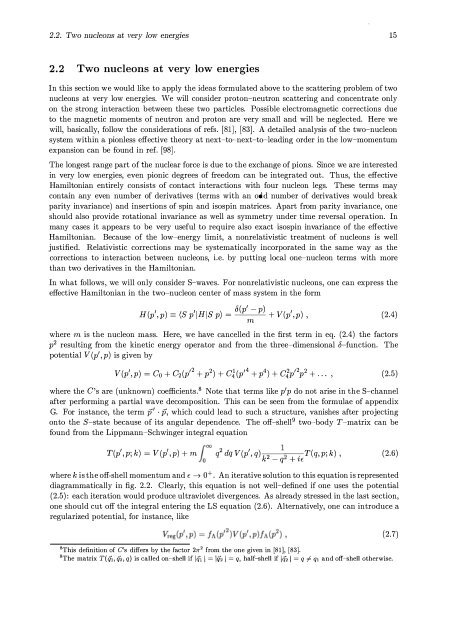The Nucleon-Nucleon Interaction in a Chiral Effective Field Theory
The Nucleon-Nucleon Interaction in a Chiral Effective Field Theory
The Nucleon-Nucleon Interaction in a Chiral Effective Field Theory
Create successful ePaper yourself
Turn your PDF publications into a flip-book with our unique Google optimized e-Paper software.
2.2. Two nuc1eons at very low energies<br />
2.2 Two nucleons at very low energies<br />
In this section we would like to apply the ideas formulated above to the scatter<strong>in</strong>g problem of two<br />
nucleons at very low energies. We will consider proton-neutron scatter<strong>in</strong>g and concentrate only<br />
on the strong <strong>in</strong>teraction between these two particles. Possible electromagnetic corrections due<br />
to the magnetic moments of neutron and proton are very small and will be neglected. Here we<br />
will, basically, follow the considerations of refs. [81], [83]. A detailed analysis of the two-nucleon<br />
system with<strong>in</strong> a pionless effective theory at next-to-next-to-Iead<strong>in</strong>g order <strong>in</strong> the low-momentum<br />
expansion can be found <strong>in</strong> ref. [98].<br />
<strong>The</strong> longest range part of the nuclear force is due to the exchange of pions. S<strong>in</strong>ce we are <strong>in</strong>terested<br />
<strong>in</strong> very low energies, even pionic degrees of freedom can be <strong>in</strong>tegrated out. Thus, the effective<br />
Hamiltonian entirely consists of contact <strong>in</strong>teractions with four nucleon legs. <strong>The</strong>se terms may<br />
conta<strong>in</strong> any even number of derivatives (terms with an ocid number of derivatives would break<br />
parity <strong>in</strong>variance) and <strong>in</strong>sertions of sp<strong>in</strong> and isosp<strong>in</strong> matrices. Apart from parity <strong>in</strong>variance, one<br />
should also provide rotational <strong>in</strong>variance as weIl as symmetry under time reversal operation. In<br />
many cases it appears to be very useful to require also exact isosp<strong>in</strong> <strong>in</strong>variance of the effective<br />
Hamiltonian. Because of the low-energy limit, a nonrelativistic treatment of nucleons is weIl<br />
justified. Relativistic corrections may be systematically <strong>in</strong>corporated <strong>in</strong> the same way as the<br />
corrections to <strong>in</strong>teraction between nucleons, i.e. by putt<strong>in</strong>g local one-nucleon terms with more<br />
than two derivatives <strong>in</strong> the Hamiltonian.<br />
In what follows, we will only consider S-waves. For nonrelativistic nucleons, one can express the<br />
effective Hamiltonian <strong>in</strong> the two-nucleon center of mass system <strong>in</strong> the form<br />
H(p',p) == (S p'lHIS p) = J(p' -p) + V(p',p) ,<br />
m<br />
where m is the nucleon mass. Here, we have cancelled <strong>in</strong> the first term <strong>in</strong> eq. (2.4) the factors<br />
p2 result<strong>in</strong>g from the k<strong>in</strong>etic energy operator and from the three-dimensional J-function. <strong>The</strong><br />
potential V(p',p) is given by<br />
p ,p = 0 + 2 P + p + 4 P + p + 4P P + . .. , (2.5)<br />
V( ' ) C C ( ,2 2 ) C1( ,4 4 ) C 2 ,2 2<br />
where the C's are (unknown) coefficients.8 Note that terms like p'p do not arise <strong>in</strong> the S-channel<br />
after perform<strong>in</strong>g a partial wave decomposition. This can be seen from the formulae of appendix<br />
G. For <strong>in</strong>stance, the term p' . p, which could lead to such a structure, vanishes after project<strong>in</strong>g<br />
onto the S-state because of its angular dependence. <strong>The</strong> off-shell g two-body T-matrix can be<br />
found from the Lippmann-Schw<strong>in</strong>ger <strong>in</strong>tegral equation<br />
T(p',p;k) = V(p',p) + m (OO q2dqV(p',q) k2 \ .<br />
Jo -<br />
q T(q,p;k) ,<br />
+ ZE<br />
where k is the off-shell momentum and E ---+ 0+. An iterative solution to this equation is represented<br />
diagrammatically <strong>in</strong> fig. 2.2. Clearly, this equation is not well-def<strong>in</strong>ed if one uses the potential<br />
(2.5): each iteration would produce ultraviolet divergences. As already stressed <strong>in</strong> the last section,<br />
one should cut off the <strong>in</strong>tegral enter<strong>in</strong>g the LS equation (2.6). Alternatively, one can <strong>in</strong>troduce a<br />
regularized potential, for <strong>in</strong>stance, like<br />
8 This def<strong>in</strong>ition of C's differs by the factor 21r2 from the one given <strong>in</strong> [81], [83).<br />
9 <strong>The</strong> matrix TUb, eh , q) is called on-shell if Iql I = 1il2 I = q, half-shell if Iq 2 1 = q i=- ql and off-shell otherwise.<br />
15<br />
(2.4)<br />
(2.6)<br />
(2.7)












